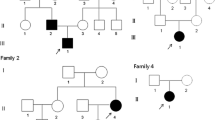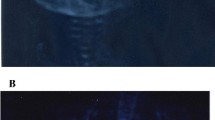Abstract
Here we report the identification of two different mutations in chloride channel 7 gene in two unrelated patients with autosomal dominant osteopetrosis type II. We determined that one patient (a 32-year-old woman) carried a heterozygous gene for a R767W mutation in exon 24, and another patient (a 17-year-old boy) carried a heterozygous gene for a novel frameshift mutation (Glu798FS) in exon 25. Recent studies have reported loss-of-function mutations in the chloride channel 7 (CLCN7) gene as a cause of autosomal dominant osteopetrosis type II (ADO-II). The identification of gene mutations in Chinese with ADO has not been reported previously. In this study, we identified mutations of the CLCN7 gene in two unrelated Chinese families with ADO-II. Two probands with ADO-II were diagnosed based on their bone characteristics on X-rays and their laboratory results. All 25 exons of the CLCN7 gene, including the exon–intron boundaries, were sequenced. We found in family 1 that the proband (a 32-year-old woman) was heterozygous for a CLCN7 mutation. The nonsynonymous mutation consisted of a heterozygous C/T transition at codon 2327 in exon 24, which resulted in an arginine (CGG)-to tryptophan (TGG) substitution at position 767 (R767W). The same heterozygous mutation (C/T) was determined in her father and son, who were asymptomatic with normal skeleton radiography. In family 2, we found that the proband (a 17-year-old boy) carried a novel frameshift mutation (Glu798FS) resulting from a G insertion between codon 60 and codon 61 in exon 25. The heterozygous –/G insertion is predicted to elongate the peptide of CLCN7 by 120 amino acids after position 797 amino acids. Similarly, some individuals of this family carried the same heterozygous mutation, but they are all asymptomatic. Furthermore, the R767W and Glu798FS mutations were not found in 100 unrelated controls. Our present findings suggest that the novel Glu798FS mutation in exon 25 and R767W in exon 24 in the CLCN7 gene were responsible for ADO-II in these Chinese patients.





Similar content being viewed by others
References
Balemans W, Van Wesenbeeck L, Van Hul W (2005) A clinical and molecular overview of the human osteopetroses. Calcif Tissue Int 77:263–274
Van Hul E, Gram J, Bollerslev J, Van Wesenbeeck L, Mathysen D, Andersen PE, Vanhoenacker F, Van Hul W (2002) Localization of the gene causing autosomal dominant osteopetrosis type I to chromosome 11q12-13. J Bone Miner Res 17:1111–1117
Van Wesenbeeck L, Cleiren E, Gram J, Beals RK, Bénichou O, Scopelliti D, Key L, Renton T, Bartels C, Gong Y, Warman ML, De Vernejoul MC, Bollerslev J, Van Hul W (2003) Six novel missense mutations in the LDL receptor-related protein 5 (LRP5) gene in different conditions with an increased bone density. Am J Hum Genet 72:763–771
Bénichou O, Cleiren E, Gram J, Bollerslev J, de Vernejoul MC, Van Hul W (2001) Mapping of autosomal dominant osteopetrosis type II (Albers-Schönberg disease) to chromosome 16p13.3. Am J Hum Genet 69:647–654
Cleiren E, Bénichou O, Van Hul E, Gram J, Bollerslev J, Singer FR, Beaverson K, Aledo A, Whyte MP, Yoneyama T, de Vernejoul MC, Van Hul W (2001) Albers-Schönberg disease (autosomal dominant osteopetrosis, type II) results from mutations in the CLCN7 chloride channel gene. Hum Mol Genet 10:2861–2867
Tolar J, Teitelbaum SL, Orchard PJ (2004) Osteopetrosis. N Engl J Med 351:2839–2849
Waguespack SG, Koller DL, White KE, Fishburn T, Carn G, Buckwalter KA, Johnson M, Kocisko M, Evans WE, Foroud T, Econs MJ (2003) Chloride channel 7 (CLCN7) gene mutations and autosomal dominant osteopetrosis, type II. J Bone Miner Res 18:1513–1518
Letizia C, Taranta A, Migliaccio S, Caliumi C, Diacinti D, Delfini E, D’Erasmo E, Iacobini M, Roggini M, Albagha OM, Ralston SH, Teti A (2004) Type II benign osteopetrosis (Albers-Schönberg disease) caused by a novel mutation in CLCN7 presenting with unusual clinical manifestations. Calcif Tissue Int 74:42–46
Frattini A, Pangrazio A, Susani L, Sobacchi C, Mirolo M, Abinun M, Andolina M, Flanagan A, Horwitz EM, Mihci E, Notarangelo LD, Ramenghi U, Teti A, Van Hove J, Vujic D, Young T, Albertini A, Orchard PJ, Vezzoni P, Villa A (2003) Chloride channel CLCN7 mutations are responsible for severe recessive, dominant, and intermediate osteopetrosis. J Bone Miner Res 18:1740–1747
Bollerslev J (1987) Osteopetrosis: a genetic and epidemiological study. Clin Genet 31:86–90
Waguespack SG, Hui SL, DiMeglio LA, Econs MJ (2007) Autosomal dominant osteopetrosis: clinical severity and natural history of 94 subjects with a chloride channel 7 gene mutation. J Clin Endocrinol Metab 92:771–778
Campos-Xavier AB, Saraiva JM, Ribeiro LM, Munnich A, Cormier-Daire V (2003) Chloride channel 7 (CLCN7) gene mutations in intermediate autosomal recessive osteopetrosis. Hum Genet 112:186–189
Kornak U, Kasper D, Bösl MR, Kaiser E, Schweizer M, Schulz A, Friedrich W, Delling G, Jentsch TJ (2001) Loss of the ClC-7 chloride channel leads to osteopetrosis in mice and man. Cell 104:205–215
Henriksen K, Gram J, Schaller S, Dahl BH, Dziegiel MH, Bollerslev J, Karsdal MA (2004) Characterization of osteoclasts from patients harboring a G215R mutation in ClC-7 causing autosomal dominant osteopetrosis type II. Am J Pathol 164:1537–1545
Chu K, Koller DL, Snyder R, Fishburn T, Lai D, Waguespack SG, Foroud T, Econs MJ (2005) Analysis of variation in expression of autosomal dominant osteopetrosis type 2: searching for modifier genes. Bone (NY) 37:655–661
de Varnejoul MC, Schulz A, Kornak U (2007) GENEReviews: CLCN7-related osteopetrosis. http://www.ncbi.nlm.nih.gov/bookshelf/br.fcgi?book=gene&part=clcn7
Chu K, Snyder R, Econs MJ (2006) Disease status in autosomal dominant osteopetrosis type 2 is determined by osteoclastic properties. J Bone Miner Res 21:1089–1097
Del Fattore A, Peruzzi B, Rucci N, Recchia I, Cappariello A et al (2006) Clinical, genetic, and cellular analysis of 49 osteopetrotic patients: implications for diagnosis and treatment. J Med Genet 43:315–325
Meadows NA, Sharma SM, Faulkner GJ, Ostrowski MC, Hume DA, Cassady AI (2007) The expression of CLCN7 and Ostm1 in osteoclasts is coregulated by microphthalmia transcription factor. J Biol Chem 282:1891–1904
Sulewska A, Niklinska W, Kozlowski M, Minarowski L, Naumnik W, Niklinski J, Dabrowska K, Chyczewski L (2007) DNA methylation in states of cell physiology and pathology. Folia Histochem Cytobiol 45:149–158
Acknowledgments
The authors thank the patients for their participation. We wish to thank two anonymous reviewers for comments that helped to improve the manuscript and our future research. The study was supported by the National Natural Science Foundation of China (NSFC) (No. 30570891, 30771019) and Program of Shanghai Subject Chief Scientist (No. 08XD14030).
Author information
Authors and Affiliations
Corresponding author
About this article
Cite this article
Zhang, ZL., He, JW., Zhang, H. et al. Identification of the CLCN7 gene mutations in two Chinese families with autosomal dominant osteopetrosis (type II). J Bone Miner Metab 27, 444–451 (2009). https://doi.org/10.1007/s00774-009-0051-0
Received:
Accepted:
Published:
Issue Date:
DOI: https://doi.org/10.1007/s00774-009-0051-0




